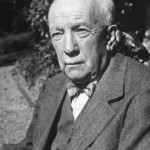
The operas of Richard Strauss show up regularly on the Canadian Opera Company calendar (next spring, it’s Salome). We also hear his Lieder from time to time, but his instrumental music doesn’t come up often in a season. The Toronto Symphony Orchestra has but one piece coming up on it’s 100-plus concert season (Don Quichote, with Sir Andrew Davis in November).
- Classical Music 101: What Does A Conductor Do? - June 17, 2019
- Classical Music 101 | What Does Period Instrument Mean? - May 6, 2019
- CLASSICAL MUSIC 101 | What Does It Mean To Be In Tune? - April 23, 2019
So it’s high time to up the Strauss quotient by having a listen to Metamorphosen, one of his masterpieces. The 25-minute piece is written out for 23 separate string parts: 10 violins, five violas and cellos and three double-basses. It is in three parts (slow, fast, slow), but they are seamless.
Equally seamless are the complex harmonic transitions and counterpoints and the every-shfting balance between consonance and dissonance, unison playing and solo lines for the instruments. Musical motifs appear and disappear constantly.
Done poorly, all this complexity is a thick sonic stew. Done well, it is a clear broth filled with a multitude of colourful morsels of sound.
This is one of those pieces one can listen to over and over again, hearing something new every time.
But does it mean anything?
It’s a question that irks people who like to think in terms of absolute music, which is meant to be above depiction of scenes or emotions or of texts. Given the technical intricacy of the structure and compositional technique in Metamorphosen, it works as absolute music.
Strauss, however, muddied the conceptual waters by leaving the inscription “In memoriam” on the score, without any further explanation. A snippet of the funeral march from Beethoven’s “Eroica” Symphony also raises questions about the composer’s intentions for a piece that was commissioned by conductor Paul Sacher for the Collegium Musicum in Zurich.
Strauss wrote this piece in the final months of World War II, having removed himself and his family from harm’s way in the Austrian mountains. He was 80 years old as he hard of the bombing of cities and opera houses and concert halls where his music had been performed and enjoyed for decades.
Musicologists have spent decades trying to figure out what, exactly, Strauss had put into the piece, and what the “In memoriam,” was really for. Given the tragic tone of the music, one can pretty much read into it whatever one wants, given the context.
A couple of days ago, I had a nice long chat with a professional musician whom I admire because of how he thinks about music and its context. We ended up talking about how there are some not-so-fine compositions that enjoy a deep connection with audiences because of their backstory, not because the music itself is so compelling.
It made me think about how so many people in the business bend over backwards to try and provide historical and musicological context, and how, once we’re aware of it, it colours our perception of what we hear.
Speculating on the intentions behind a piece like Metamorphosen can, in fact, become an extreme example. For example, if “In memoriam” is meant as a sad farewell to the Third Reich, I might be tempted to not listen at all, or to listen askance.
If, on the other hand, the inscription is for the loss of the opera house in Strauss’s birth city, Munich, where his final opera (the gorgeous Capriccio) had been premiered just three years earlier, one can feel intense pangs of sympathy as the piece unfolds.
It makes me think that, sometimes, it may be best to not ask too many questions if there are no ready answers, and merely enjoy music as music, especially when it is as absolutely powerful as Metamorphosen.
Interpretations vary by as much as 8 minutes, which is a huge spread for a piece this short. Here is one of the classic recordings, by conductor Eugene Ormandy and Yannick Nézet-Séguin’s new, fresh-out-of-bankrupty-proceedings Philadelphia Orchestra:
John Terauds
- Classical Music 101: What Does A Conductor Do? - June 17, 2019
- Classical Music 101 | What Does Period Instrument Mean? - May 6, 2019
- CLASSICAL MUSIC 101 | What Does It Mean To Be In Tune? - April 23, 2019



